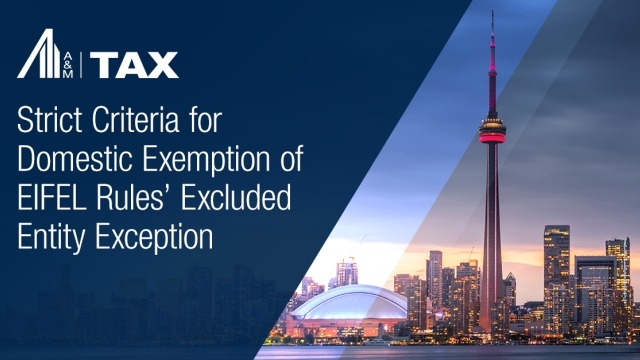New “Tax” Causes Waves in the UK North Sea
The last couple of years have seen positive changes mainly in the form of additional tax allowances to encourage investment in both offshore UK Continental Shelf (UKCS) exploration and onshore exploration for unconventional hydrocarbons (e.g., shale gas). However, new legislation introduced in April 2014 relating to bareboat chartering / leasing costs is probably just as significant, if not more, as the increase in the supplementary tax charge to 32 percent three years ago, and has caused significant concern within the industry.
Importantly, this development not only appears to be more than just an esoteric adjustment to the taxation of contractors and producers in the UKCS, but also an early sign of things to come i.e. addressing concerns of economic activity and large fund flows without the UK Exchequer receiving a slice, and so artificially defining profit to tax. In parallel, the Base Erosion and Profit Shifting (BEPS) reviews will seek to follow this result.
The new measure in respect of bareboat chartering costs was first announced at the Autumn Statement in 2013 with draft legislation being published in Finance Bill 2014.
The UK Government firmly believes that companies operating in the UKCS should be paying their fair share of tax. As a large proportion of the assets deployed by oil and gas service contractors are held offshore, the perception is that a significant amount of UK tax is being lost through leasing payments being made to connected parties for use of these assets as bareboat charters to offshore entities with no taxable presence in the UK. HM Treasury estimates this to be up to 90 percent of operating profits made in the UKCS.
The Change
The legislative changes effective 1 April, 2014 introduce two key measures:
1.) Cap the tax deduction available for bareboat charter / leasing payments made to associated persons (e.g., another company in the same group) by companies operating in the UKCS respective of relevant assets, which can be moved from place to place without major dismantling or modification and can be used for drilling or accommodation – mainly rigs and flotels. The cap has been set at 7.5 per cent of the sum of the historical cost of the asset plus any subsequent capital expenditure incurred by an associated person. HM Treasury may, by regulations, change the percentage. The cap is prorated for the number of days in the accounting period that the relevant asset is utilised in an offshore service. The percentage is also proportionately reduced if the accounting period is less than 12 months.
The cap applies where the relevant asset or any part of it is leased (whether by the contractor or not) from an associated person other than the contractor, and the asset has a market value of £2million or more. Associated person represents the contractor or any person who is or has been connected with the contractor. In practice, therefore, it will apply to bareboat charter / leasing payments made by a producer to a contractor and leasing payments made by a contractor to a connected person who is the owner of the assets.
2.) Profits arising from the leasing of relevant assets, where carried out by a contractor as part of a trade, are deemed to be a separate trade and accordingly ring fenced. This means that various restrictions will apply on reliefs available. For example, losses incurred by the contractor may not be offset against its ring fence profits unless those losses arose from oil contractor activities. Similarly, group relief may only be available to the extent that losses surrendered to the contractor arose from oil contractor activities. No deduction is allowed for management expenses of a company’s investment activities against the ring fence profits.
If bareboat charter / leasing payments are capped, the excess payments can be offset against the contractor’s other non-ring fence profits or if there is a loss, then surrendered as group relief against other non-ring fence group profits. It should be noted that the deduction available is subject to normal rules regarding tax deductibility of the payments and transfer pricing. Tax relief would, therefore, be available only at 21 per cent (current corporation tax rate) as opposed to a 62 percent (or even 81 percent on PRT paying fields) effective tax rate on ring fence profits.
The Impact
The UK Government estimates this measure to raise an additional £535million in tax revenue over the next five years, with an economic cost in terms of increased day rates charged by contractors for drilling and accommodation bareboat charters (assuming they will pass on this additional cost to producers) by up to 10 percent .
Although there has been consultation within industry and the Government has stated that the impact of this measure will be reviewed 12 months after implementation, it has caused some consternation within the industry in view of the economic impact, which some industry stakeholders believe to be more significant than the Government.
All countries police natural resources with zeal and want to ensure they maximise revenue from their exploitation. However, a risk occurs if fiscal changes such as this new measure cause a significant economic impact –particularly when margins are already being squeezed due to high operating costs – investment levels can be adversely affected, with companies moving to invest in other more profitable or new markets (e.g., Mexico).
These changes may also bring an incentive for companies operating in the UKCS to switch contracts from associated persons to third parties in order to avoid the capping. However, A&M expects this would depend on a number of factors including overall economic returns that can be achieved on a group basis.
Conclusion
The reaction from both sides of the fence is understandable. From the industry, concern on the economic impact and competitiveness – particularly at a time when operating costs in the UKCS are at an all time high and exploration low; and from the Government, the urgent need to ensure that all players in the UKCS are paying their fair share of tax and that most of the profits from activities connected with exploration and production in the UKCS are kept within the UK tax net.
Commissioned by the Government, the Wood Report1 highlights the need for fiscal stability consistent with the challenges of maturity2 as one of the key issues to be addressed in maximising economic recovery from the UKCS. It is estimated that 42 billion barrels of oil equivalent (BOE) have already been produced from the UKCS and that a further 12 to 24 billion BOE could be produced.
The Government appears to be committed to supporting the findings of the Wood report and a review of the tax treatment of companies operating in the UKCS announced at Budget 2014. In fact, the Financial Secretary to the Treasury recently met with industry heads in Aberdeen to kick off the fiscal review of the industry. It will be interesting to see the outcome of those discussions and A&M will continue to monitor this development.
Currently, it is unclear how the Government will deliver a stable fiscal regime in the medium to long term for the UKCS (if it expects to implement the recommendations in the Wood report) with such material tax changes being introduced. It should also be noted that the Government’s attention to security of energy supply appears to be focused on domestic shale gas and Norwegian gas (and associated infrastructure). Wind power incentives are to be scaled back, as well as subsidies for gas storage and the rebirth of nuclear power generation is still in its early stages.
All of these developments add to the wave of uncertainty for both well-established players and new entrants into the UKCS. A&M, therefore, welcomes the wider review of the tax regime applicable to companies operating in in this area and remains hopeful that it will result in positive steps to achieve stability and further investment in the UKCS.
Author:
Jagdip Bharij
Senior Director
+44 207 663 0793
For More Information:
Tax
1 UKCS Maximising Recovery Review by Sir Ian Wood dated 24 February 2014.
2 UKCS is regarded as a mature basin for oil and gas exploration and production.2




